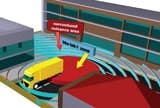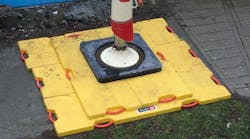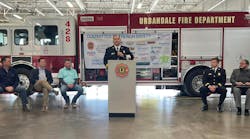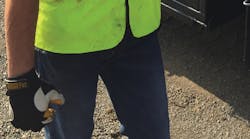Those of us who spend our working days on construction sites are intimately familiar with the beeping of back-up alarms on jobsite vehicles. Then again, so too are people on the next block.
Knowing the sound is one thing; knowing exactly where the sound is coming from is indeed another. Lives are at stake.
Now, thanks to broadband sound alarm products developed by Brigade Electronics, noise pollution control and safety don't necessarily have to battle for space on the jobsite.
It was the potential safety benefits that first attracted Chris Hanson-Abbott, chairman of U.K.-based Brigade, when he learned about the locatable traits of broadband sound.
"A blind person could point instantly in the direction that the sound is coming from," says Henry Morgan, Brigade director and general manager.
Studies identifying traditional reasons behind backing-up accidents confirmed Hanson-Abbott's belief.
"When it comes down to the audible warning part of it, the accidents happen because the alarms get tuned out," says Morgan. "People ignore them, because they're associated with the irritation of a truck backing somewhere in the neighborhood, rather than the danger warning signal. If you have a look at what a back-up alarm is meant to do, your normal beep actually doesn't do it particularly well, if at all.
"A lot of people complain and report that either the back-up alarms get spoiled, bunged up or cut, because they're a constant irritation to people working on site. When you replace the tonal alarm — the beeping — with the broadband, you eliminate all of those things."
Based on Hanson-Abbott's observation, Brigade Electronics acquired a license for the broadband patent, and eventually developed the bbs-tek product family.
The "Shhh . . . Shhh" of the broadband alarms is "contained in and around the danger zone," meaning less decibels can actually end up having more effect because the sound is directed where it is intended, says Morgan.
"It was only once we started doing full trials that we suddenly would realize the environmental benefits."
And this is where markets are being created now.
Brigade first presented its technology to New York City officials in February 2005. Almost three years later, the BBS-92 was the only back-up alarm listed in Gotham's new noise control code that comes into effect Jan. 1.
With a U.S. subsidiary headquartered in New York, Brigade has also made presentations to officials in such cities as Seattle and Phoenix, says Morgan. Since safety is clearly most important, public officials have traditionally had to tread lightly on the noise concerns, "but if there is an alternative, then they'll start demanding it."
At present, the Port of Houston Authority is in the process of retrofitting equipment at work on the Bayport Terminal construction project.
The bbs-tek alarms are similar in size and material as traditional tonal alarms. In fact, one Brigade model uses the same bolt holes as the traditional alarms on Caterpillar equipment, allowing for complete interchangeability, says Morgan. However, the location must be correct.
"That does not work with the broadband. It needs to be on the back of the vehicle as if it's a back-up light pointing into the hazard zone."
Even people who have never before heard a bbs-tek alarm "know instantly" which way to look, because of the locatable sound, says Morgan. "It's a hear-look-learn experience."






